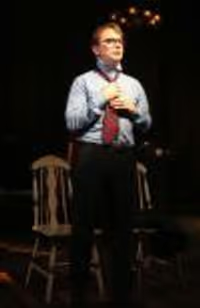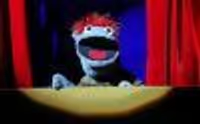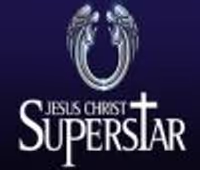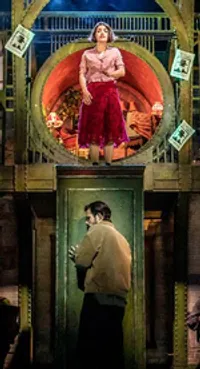Maria Friedman to bring her acclaimed Merrily We Roll along to Boston- Is a Broadway transfer in its future?
#25Maria Friedman to bring her acclaimed Merrily We Roll along to Boston- Is a Broadway transfer in its future?
Posted: 3/25/17 at 8:24am
The design was atrocious, and I still don't care for most of the post-Broadway replacements and additions, but it would be better than never getting a revival.
Also, there would be absolutely and obviously no point in doing this show chronologically.
#26Maria Friedman to bring her acclaimed Merrily We Roll along to Boston- Is a Broadway transfer in its future?
Posted: 3/25/17 at 8:28am
The story might be clearer told chronologically, but you can't just flip it. If you did, the show would begin with Our Time and end with That Frank. The score, just like the book, was structured specifically to go backwards. I'm not convinced the show will ever work, but flipping the structure won't help it either.
#27Maria Friedman to bring her acclaimed Merrily We Roll along to Boston- Is a Broadway transfer in its future?
Posted: 3/25/17 at 8:44am
Scarywarhol said: "Also, there would be absolutely and obviously no point in doing this show chronologically. "
There's also absolutely and obviously no point in being negative unless you have a better idea.
wonderfulwizard11 said: "The story might be clearer told chronologically, but you can't just flip it. If you did, the show would begin with Our Time and end with That Frank. The score, just like the book, was structured specifically to go backwards. I'm not convinced the show will ever work, but flipping the structure won't help it either."
Well, it takes a little more work than that. I never explicitly denied that. Maybe one can avoid the college wrap-around and structure it as a flashback. Start with "That Frank," and then after this scene setting up where our characters are now, turn back the clock to the "Seventh Transition" (running 'backwards,' of course) into "Opening Doors." Here they are as cynical broken adults; boom, here they were as wide-eyed young idealists trying to make it. At the end, maybe we do something with a scene based on one of the college wrap-arounds to replace the slot where the scene featuring "That Frank" would fit, and lead it into one final flashback to when he held the world in his hands like these kids: "Our Time."
As for the score being structured that way, while true, I do feel that, flipped back to front, it would just continue in the grand Sondheim tradition of building a reprise into something bigger (i.e., as their characters develop richer inner lives over time, the songs gain more meaning and carry more weight, in terms of structure and substance). That's not a hand-wave by any means; I genuinely think it might gain something just from trying it that way and seeing what happens.
Broadway Legend
joined: 5/1/05
Blocked: After Eight, suestorm, david_fick, emlodik, lovebwy, Dave28282, joevitus, BorisTomashevsky, Seb28
#28Maria Friedman to bring her acclaimed Merrily We Roll along to Boston- Is a Broadway transfer in its future?
Posted: 3/25/17 at 9:17am
I mean, you're free to think that way of course, but I still think you're making it sound far too easy. And it's not just the opening/closing numbers- the whole score is structured to build in a certain way, and the book, imperfect though it is, does the same. What you're suggesting would require rewriting large portions of George Furth's work. Maybe it would be interesting, but it wouldn't be Merrily We Roll Along.
In general, I also push back at the notion that the show needs a radical reconstruction. I certainly won't argue it works entirely, but I think a good production can have a strong emotional impact and be worthwhile. A show being flawed doesn't mean scrapping it and starting over.
#29Maria Friedman to bring her acclaimed Merrily We Roll along to Boston- Is a Broadway transfer in its future?
Posted: 3/25/17 at 9:35pm
wonderfulwizard11 said: "I mean, you're free to think that way of course, but I still think you're making it sound far too easy."
I mean, I think it kind of is easy, but no one believes me. And I also don't think rewriting on a large scale is necessary either. But that will take time and experimentation, the latter of which the copyright holders won't allow, making the former moot.
"A show being flawed doesn't mean scrapping it and starting over."
Well, this isn't scrapping it or starting over per se. I mean, all of the same material is still there.
Broadway Legend
joined: 5/1/05
Blocked: After Eight, suestorm, david_fick, emlodik, lovebwy, Dave28282, joevitus, BorisTomashevsky, Seb28
Rick906
Swing Joined: 9/12/09
#30Maria Friedman to bring her acclaimed Merrily We Roll along to Boston- Is a Broadway transfer in its future?
Posted: 3/26/17 at 12:39am
This is an incomprehensibly bad production.
#31Maria Friedman to bring her acclaimed Merrily We Roll along to Boston- Is a Broadway transfer in its future?
Posted: 3/26/17 at 3:42am
Sondheim did indeed write the score to be played in reverse chronological order. As many of you probably know, he has also said that "If the score is listened to in reverse order [ie, standard chronological order] - although it wasn't written that way - it develops traditionally", in the sense of 'reprises' coming after the 'main' version of each song and so forth. I have no strong opinion on whether 'flipping' the show would be a good thing from a dramatic perspective, but it's an interesting tidbit about the score.
#32Maria Friedman to bring her acclaimed Merrily We Roll along to Boston- Is a Broadway transfer in its future?
Posted: 3/26/17 at 7:24am
No doubt the result of careful effort, but unquestionably useful for my proposed approach. :)
Broadway Legend
joined: 5/1/05
Blocked: After Eight, suestorm, david_fick, emlodik, lovebwy, Dave28282, joevitus, BorisTomashevsky, Seb28
#33Maria Friedman to bring her acclaimed Merrily We Roll along to Boston- Is a Broadway transfer in its future?
Posted: 3/26/17 at 2:50pm
In its current form, the show works very well for me. It does require a LOT of work on the audience's part however. I feel that if an audience member really wants to appreciate how great the show is, they have to be able to think in TWO directions at the same time. I think you have to constantly be aware of the question: "How did you get there from here?", as opposed to the traditional "What will happen next?" kind of structure.
When the answers to plot questions are revealed (as we move backwards in time) I think an audience member also has to be mentally flexible enough to remind themself that when those answers appear in the show, they're not cues regarding something that HAS happened, but something that WILL happen (even though we're constantly moving backwards in time). You have to be able to process the plot in both directions.
I enjoy that a LOT! ![]()
I do have one unanswered plot point, though. Why are Charley's wife Evelyn
who we find out is Mary's roommate in the final/first scene of the show
and his child
(son? daughter?)
absent from show? What ever happened to them? What did I miss?
PS: I understand why the decision was made to put sweatshirts with character IDs on the original cast members. I didn't have too much trouble following the plot paths of the three leads, but until recently, I've always had a difficult time following the paths of the supporting characters.
One thing that made their paths less cloudy for me was to watch a video of the Australian production (here) while following along with the digital booklet that's included with the Encores! recording. I found that "crutch" to be very helpful.
#34Maria Friedman to bring her acclaimed Merrily We Roll along to Boston- Is a Broadway transfer in its future?
Posted: 3/26/17 at 3:19pm
John Adams said: "In its current form, the show works very well for me. It does require a LOT of work on the audience's part however. I feel that if an audience member really wants to appreciate how great the show is, they have to be able to think in TWO directions at the same time. I think you have to constantly be aware of the question: "How did you get there from here?", as opposed to the traditional "What will happen next?" kind of structure.
When the answers to plot questions are revealed (as we move backwards in time) I think an audience member also has to be mentally flexible enough to remind themself that when those answers appear in the show, they're not cues regarding something that HAS happened, but something that WILL happen (even though we're constantly moving backwards in time). You have to be able to process the plot in both directions.
I enjoy that a LOT! ![]()
I do have one unanswered plot point, though. Why are Charley's wife Evelyn
and his child
absent from show? What ever happened to them? What did I miss?
PS: I understand why the decision was made to put sweatshirts with character IDs on the original cast members. I didn't have too much trouble following the plot paths of the three leads, but until recently, I've always had a difficult time following the paths of the supporting characters.
One thing that made their paths less cloudy for me was to watch a video of the Australian production (here) while following along with the digital booklet that's included with the Encores! recording. I found that "crutch" to be very helpful."
The Aussie production also features a far more thoughtful design approach that helps the audience understand the time shifts, something the original bleachers just didnt handle well.
Videos






